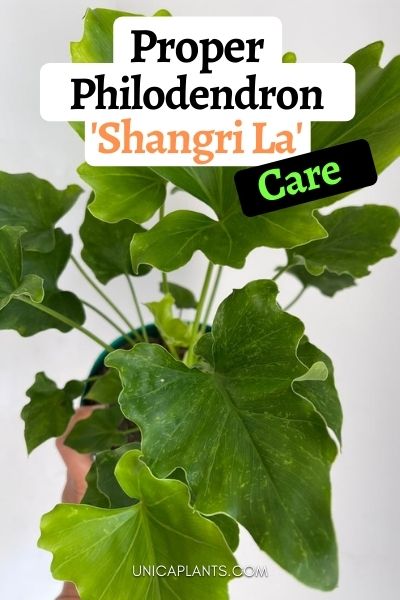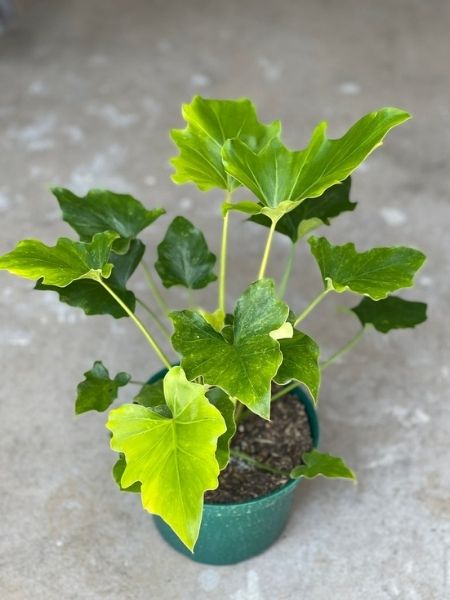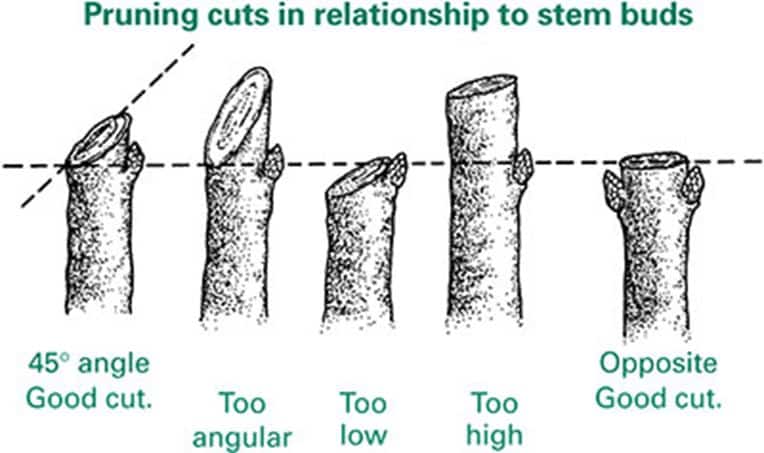The Philodendron bipinnatifidum 'Shangri La' (also known as the Philodendron 'Shangri La') has a special place in the colorful kingdom of popular plants. It has an exotic appearance, tropical origin, and is easy to grow.
As a general rule, the Philodendron bipinnatifidum 'Shangri La' prefers a lot of indirect lighting, moderate watering, well-drained soil, which does not retain a lot of moisture, and additional fertilization once a month during the growing season.
This irresistible novelty originated from the rainforests across South America is presented by Ball Ingenuity in 2021. It's a beautiful plant that brings a tropical atmosphere to any space.
Even among so-called split-leaf Philodendrons, the 'Shangri La' variety stands out with its large, deeply divided lacy leaves that grow on tall, sturdy stems creating dense, bushy, compact forms. Its attractiveness is additionally enhanced by lime-green ribs that accentuate the foliage texture.
Despite its exotic appearance and tropical origin, this plant is easy to grow and will show it's decorative potential rather fast.
Images by Plantaroots.

Summary:
- Light: Bright indirect sunlight
- Water: Only water when the top 2 inches of the soil are dry
- Soil: Well-draining soil mix
- Fertilizer: Once a month (during growing seasons)
- Size: Grows up to 3 feet (90 cm) tall
- Size: Leaves grow up to 2 feet (60 cm) long
- Temperature: Between 65 and 80ºF (18 and 27ºC)
- Humidity: At least 50%
- Cold hardy: Winter hardy only in US climate zone 9 to 11
- Propagation: By stem tip cuttings and division
- Toxicity: Toxic to humans and animals
Contents
- General care for Philodendron bipinnatifidum 'Shangri La'
- Water
- Light
- Soil
- Fertilizing
- Temperature
- Humidity
- Repotting
- Pruning
- Diseases
- Pests
- How to propagate Philodendron bipinnatifidum 'Shangri La'
- Division
- Stem tip cuttings
- Related questions
- Why does my Philodendron 'Shangri La' have brown tips?
- Why are the leaves of my Philodendron 'Shangri La' yellowing?
- Why is my Philodendron 'Shangri La' leggy?
- Is the Philodendron 'Shangri La' toxic?
- Are the Philodendron 'Shangri La' and Selloum Philodendron the same?
General care for Philodendron bipinnatifidum 'Shangri La'
Water
The Philodendron 'Shangri La' likes moist but not soaked soil.
The general rule is to water this plant once a week, from spring to fall, but this always depends on the overall growing conditions, including temperature, light exposure, plant or pot size. And from autumn to spring, reduce watering to once every fifteen days. Shortening the day in that period slows down the transpiration process, so the plant needs less water.
If you are not sure if it is time to next watering, feel the surface of the substrate with your finger. If the top 2 inches of the soil feel dry, the plant needs a new water dose! Although it loves moisture, the 'Shangri La' will rise easier if you skip some watering than if you overdo it!
Ten or fifteen minutes after watering, check the tray and be sure to pour out any water that may have accumulated. Philodendron is sensitive to excess water around the root system, which can easily lead to root rot.
Tap water contains chemicals that can have a detrimental effect on the plant in the long run. Therefore, it is best to water the plant with soft water at room temperature, which has stood for at least 24 hours.
Light
Originating from shady tropical forests, Philodendrons are not accustomed to direct sunlight, especially in the hottest part of the day. The Philodendron 'Shangri La' is no exception! Therefore, to make your plant happy chose a bright spot with a lot of filtered, diffused lighting. The ideal positions are next to the east and west windows, close to the north window, or a few feet from the south window.
This plant can tolerate relatively shady positions, but in this case, it will grow more slowly, the leaves will be smaller, and their color may be less intense.
If you like this kind of content, check out Care and Grow Guide for Alocasia maharani!
Soil
The Philodendron 'Shangri La' prefers aerated and light soils, rich in nutrients, with good drainage. In better-equipped garden centers, you can find special mixtures for Philodendrons or exotic plants. Such substrates are created according to the specific needs of tropical plants and provide optimal support for their cultivation.
If you cannot find such a specialized substrate, then you can make your mixture by combining equal parts of all-purpose substrate, peat moss, and perlite. The combination provides necessary nutrients, high permeability, lightness, and aeration of the soil.
Fertilizing
The charming Philodendron 'Shangri La' is a fast-growing type and benefits from additional nutrients. Water-soluble fertilizers with increased nitrogen content (NPK 3: 1: 2) will provide the necessary nutrients for its large, mighty leaves.
Once a month, during the active growth phase, from spring to fall, add liquid fertilizer while watering the plants, following the doses indicated on the package.
As an evergreen plant, Philodendron 'Shangri La' does not have a complete dormant phase. However, due to the reduced amount of light in autumn and winter, the plant's metabolism slows down, and it does not need additional nutrition.
Temperature
In U.S. climate zone 9 to 11, the Philodendron 'Shangri La' can be grown outdoors in a shaded part of the garden, out of direct sunlight. In all other climatic zones, it is treated as a houseplant protected from low winter temperatures.
The optimal temperature for growing this plant ranges from 65 to 87 F throughout the year. The lower minimum that it can withstand without damage is 55 F. It means you could not leave the plant in an unheated room in winter.
In addition, large temperature differences between day and night and exposure to drafts and cold air currents can also negatively affect the plant.
Humidity
Like all other Philodendrons, the 'Shangri La' loves elevated moist similar to its homeland. As a very adaptable plant, it can withstand the humidity of 30 to 50%, which is the average value in our living spaces.
Yet, it grows much better and more abundantly if the humidity level is at least 50% or more. Increasing humidity in a room might sound too demanding, but fortunately, there are a few simple ways to achieve it!
- Misting the leaves is the simplest way to provide the plant with the required moisture amount in the air. Twice a week, using the stagnant soft water at room temperature, spray the leaves of your plant.
In addition to providing the plant with a pleasant refreshment, misting is also a practical way to wash away dust or particles accumulated on the leaves (which can help prevent pests & diseases and keep the plant healthy). - Use a humidifier that will make all your tropical plants feel right at home!
- Place your plant on a pebble tray with water.
Repotting
The aboveground part of the plant develops faster than the roots, so you transplant the Philodendron only when the root ball becomes compact and fills the pot, usually every second or third year. When repotting a plant, replace the previous pot with a 2 or 3 inches larger one.
The 'Shangri La' belongs to the group of Philodendrons that likes to be root-bound. If you transplant it into a much larger pot, the plant will focus its energy on root development instead of leaf development.
This plant does not like to be disturbed, and transplanting can cause stress, due to which the plant can stagnate for some time until it adapts. It is most painless to transplant the plant in early spring before it begins more intense seasonal growth.
Pruning
Unlike the Philodendrons that grow as vines, Philodendron 'Shangri La' is a herbaceous plant that does not need pruning. However, regular removal of all damaged or withered leaves certainly contributes to its more attractive appearance.
Diseases
Generally speaking, Philodendrons are quite resistant plants and are not prone to diseases or pests. However, it does not mean that they are immune to problems they may cause.
Bacterial leaf spot disease most likely is the consequence of high humidity. You would recognize it by brown spots, often with yellow edges. If the disease is not too advanced, try to remove the affected leaves, and for the next few weeks. Do not spray the leaves of the plant, and water just enough so that the plant is not completely dry.
If the disease has widely spread, remove the most attacked leaves and treat the plant with some standard fungicides for houseplants.
Pests
Occasionally, the Philodendron 'Shangri La' could be exposed to the attack of common houseplants pests such as spider mites, thrips, aphids, and scale. These tiny insects feed on plant sap causing various deformations and damages such as twisting of leaves or corroded leaf surface.
In addition to weakening the plant, pests are dangerous because they often transmit viruses that cause diseases from which the plant is difficult to recover.
Regular inspection of the plant will detect the presence of pests in time and prevent them from seriously endangering your Philodendron 'Shangri La'. Luckily, there is a whole range of effective products in the market that can help you fight this scourge from classic chemical insecticides to natural preparations such as neem oil or insecticidal soaps.
If you like this article, check out How to Care for and Grow Alocasia 'Sumo'.

How to propagate Philodendron bipinnatifidum 'Shangri La'
Division
If you have an adult plant with many stems, the simplest way to propagate it is to divide it. Following the listed step-by-step procedure, you would easily get new specimens from the existing plant!
- Carefully remove the plant from the pot.
- Immerse it in a bucket of water and leave for 15 to 20 minutes.
- Take out the bull and let it drain. Remove all soil from and around the root bale. When the root is clean, inspect it and remove any damaged, crushed, or unhealthy parts.
- Usually, several stems of the plant grow from the same part of the root. Separate these parts from the rest of the bale. If the root veins are so intertwined that you cannot separate them by hand, use a sharp, clean knife.
- Place each separate part in a small container that you have previously half-filled with a mixture of substrate and perlite.
- Cover the root and white part of the stems with the substrate
- Water the plant and place it in a warm ( 70-80F) and bright spot without direct sunlight. Typically, the plant needs two or three weeks to adapt and start new growth.
Stem tip cuttings
In the spring or early summer, you can propagate your Philodendron 'Shangri La' using stem tip cuttings.
- Remove a 6-inch stem from a healthy philodendron plant.
- Make a clean cut with a pair of scissors, gardening clippers, or a sharp knife, cutting the stem just below a set of leaves.
- Pinch off two or three sets of leaves so at least two leaf nodes on the stem are bare.
In about 10 days, the stem will start to form roots. After the roots have formed you can plant the cutting in Philodendron soil mix. Or make a mix with equal parts of all-purpose substrate, peat moss, and perlite.
Cuttings in a transparent glass with water will allow you to monitor the development of the roots. During the propagation time, maintain the same water level in the glass. When the cutting has developed enough root veins, it is time to transplant it into a separate container.
On the other hand, if you put the cutting directly into the substrate, you will not see the development of the roots - the forming of new leaves is an indication that the process is complete and that the cutting has become a new stand-alone plant!
Related questions
Why does my Philodendron 'Shangri La' have brown tips?
Brown leaf tips on a Philodendron 'Shangri La' can be a sign of dry air or insufficient watering. Moisture in the air and the soil is necessary for the proper and healthy appearance of the plant. If one of these two factors is disturbed, the damage occurs first on the peripheral parts of the leaves – their tips!
Why are the leaves of my Philodendron 'Shangri La' yellowing?
Yellow leaves that wither most often suggest excess water around the root system. Sometimes this is the result of too enthusiastic watering! Philodendron 'Shangri La' loves moisture, but the successful growth of the plant begins with establishing a proper watering regime!
As soon as you notice yellow, flabby leaves reduce watering! If adverse conditions continue and the plant sits in the water for a long time it will most likely cause root rot which usually means loss of the plant.
Why is my Philodendron 'Shangri La' leggy?
If you place your Philodendron 'Shangri La' in a shady spot, the plant will survive, but instead of a gorgeous, dense tropical shrub, it will grow as a scattered plant that does not have a bushy form.
The lack of light slows down the growth of new leaves, and the leaf stalks elongate, trying to reach enough light. The plant becomes leggy, distorted, and loses its fairly regular domed shape.
The solution to this problem is simple. Move the plant to a place where it will receive more light. Also, rotate the plant at least twice a month to prevent the plant from twisting towards the light source!
Is the Philodendron 'Shangri La' toxic?
Although Philodendron 'Shangri La' is a botanical novelty, the individuals from which this variety developed retained the toxicity inherent in all plants of the Araceae family. All its parts contain calcium oxalate, a substance that causes skin irritation. Moreover, if calcium oxalate comes into the digestive tract, it can cause serious health problems, such as vomiting and diarrhea.
Are the Philodendron 'Shangri La' and Selloum Philodendron the same?
Despite many similarities, these are two different plants. Both belong to the so-called split-leaf Philodendrons and have similar deeply lobed leaves making them easy to confuse, especially when it comes to young plants.
However, among other things, Philodendron 'Shangri La' grows in a completely different form. It is bushy and does not form the trunk characteristic of a robust and much larger Selloum.
If you like this article, check out Variegated Ficus elastica Brown Spots on Leaves!



